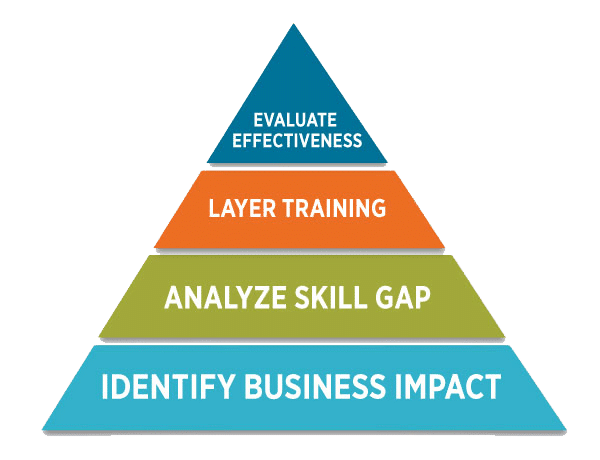What is Employee Training and Development?
HOW TO DEVELOP A TRAINING PROGRAM FOR EMPLOYEES
High-impact training and development programs don’t just happen. Instead, they’re the result of a careful planning and alignment process. The following steps can help you translate business objectives into a tailored training plan.
- Identify Business Impact: Design and develop your training to meet the company’s overall goals. Keeping business goals in focus ensures training and development makes a measurable impact. This will also help you to set a baseline for later, if you need to know how to improve employee training programs, how to develop a curriculum for training, and how to track employee training results.
- Analyze Skill Gaps: How are your employees’ behaviors helping meet the business goal? By finding out what the gaps are between employees’ current and ideal skills, you can better pinpoint what your specific learning objectives should be. Categorize these learning objectives into these three groups, and have activities in your training plan that target all three.
- Motivation: How can you help learners understand why they need to change their behaviors? By working with employee motivations–for example, pinpointing a purpose–you’re more likely to change behavior over the long term.
- Skills Mastery: What do your learners need to be able to do the job? These behaviors will have the most impact on performance.
- Critical Thinking: What must your learners know to perform their jobs well? Distinguish critical knowledge from nice-to-know information to identify what content should be in the course, and what should be in optional resources.
- Layer Training Methods: The most effective training programs use layered, sustainable learning activities to create performance improvement over time. A layered approach makes sure your program targets the essential employee, customer, and business needs while training the right people at the right time in the right way. A layered approach is the best of all worlds because it blends learning experiences and training methods that maximize the benefits of your time.
- Evaluate Effectiveness and Sustain Gains: Employees’ need for training and support don’t end when they get back to work. In fact, continued support is required to ensure that initial training sticks. Measurable learning objectives are the foundation for you to evaluate an initiative’s impact.
Bonus Tip: Need more on how to develop a curriculum for training? You can read and save our blog on How to Develop an eLearning Curriculum.

How to Improve Employee Training
A successful employee training and development program should be engaging to be effective. Use of self-directed learning, creative services to incorporate video and animations, and other technology integrations and enhancements that prioritize the learner experience will improve learning outcomes – and get organizational results.
Visit our creative services page to learn more about learning enhancements that include:
UX and Interface Design Motion Graphics AR/VR Instructional Media Video Branding & Identity Accessibility
Top companies invest in corporate training programs because they know the investment pays off in individual and organizational benefits.
Here are a few examples:
Organization
- Profit growth
- Reduced employee turnover
- Deeper talent succession pipelines
Individual
- Increased employee motivation
- Improved engagement
- Improved productivity speed and competency

EMPLOYEE ONBOARDING FOR THE MODERN WORKPLACE
- Learn how to develop an effective employee training & development onboarding process in the modern workplace.






